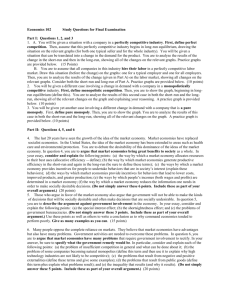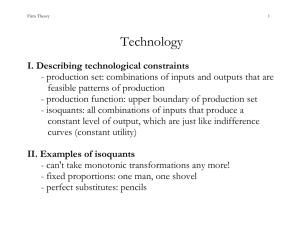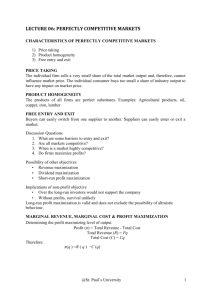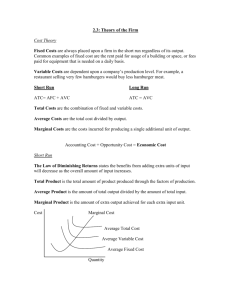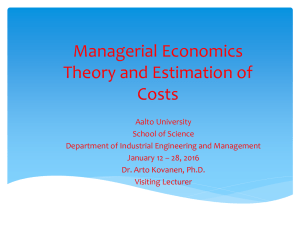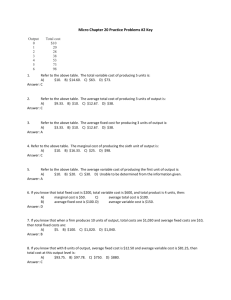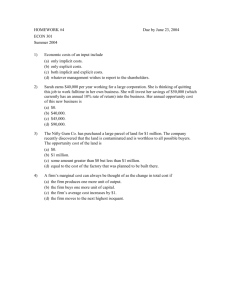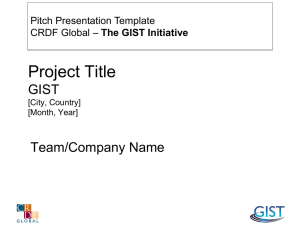Microeconomics I
advertisement
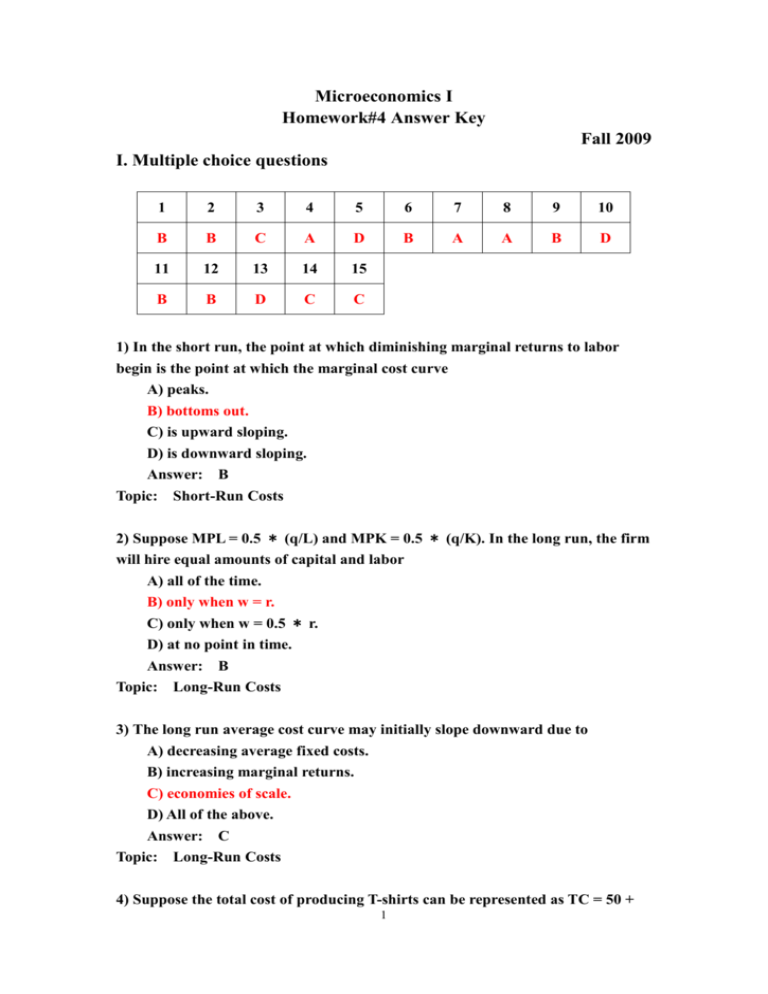
Microeconomics I Homework#4 Answer Key Fall 2009 I. Multiple choice questions 1 2 3 4 5 6 7 8 9 10 B B C A D B A A B D 11 12 13 14 15 B B D C C 1) In the short run, the point at which diminishing marginal returns to labor begin is the point at which the marginal cost curve A) peaks. B) bottoms out. C) is upward sloping. D) is downward sloping. Answer: B Topic: Short-Run Costs 2) Suppose MPL = 0.5 ∗ (q/L) and MPK = 0.5 ∗ (q/K). In the long run, the firm will hire equal amounts of capital and labor A) all of the time. B) only when w = r. C) only when w = 0.5 ∗ r. D) at no point in time. Answer: B Topic: Long-Run Costs 3) The long run average cost curve may initially slope downward due to A) decreasing average fixed costs. B) increasing marginal returns. C) economies of scale. D) All of the above. Answer: C Topic: Long-Run Costs 4) Suppose the total cost of producing T-shirts can be represented as TC = 50 + 1 2q. The marginal cost of the 5th T-shirt is A) 2. B) 10. C) 12. D) 60. Answer: A Topic: Short-Run Costs 5) Suppose the cost of producing two goods, x and y, can be represented as C = ax + by + cxy. If there are economies of scope, then which of the following must be true? A) c > 0 B) a + b = -c C) c = 0 D) c < 0 Answer: D Topic: Cost of Producing Multiple Goods 6) A production possibilities frontier that is a bowed-inward line implies A) economies of scale. B) diseconomies of scope. C) economies of scope. D) no economies of scope. Answer: B Topic: Cost of Producing Multiple Goods 7) There are 10 identical internet service providers (ISPs) in a city serving a market demand with an elasticity of -1.5. The elasticity of supply for each firm is 3.0. The elasticity of demand faced by an individual ISP provider is: A) -42 B) -15 C) -1.5 D) -27 Answer: A Topic: Competition 8) In a perfectly competitive market, A) firms can freely enter and exit. 2 B) firms sell a differentiated product. C) transaction costs are high. D) All of the above. Answer: A Topic: Competition 9) A small business owner earns $50,000 in revenue annually. The explicit annual costs equal $30,000. The owner could work for someone else and earn $25,000 annually. The owner's business profit is ________ and the economic profit is ________. A) $20,000, $5,000 B) $20,000, -$5,000 C) $25,000, -$5,000 D) $45,000, -$5,000 Answer: B Topic: Profit Maximization 10) The above figure shows the cost curves for a competitive firm. If the market price is $15 per unit, the firm will earn profits of A) $0. B) $4. C) $40. D) $160. Answer: D Topic: Profit Maximization 11) The above figure shows the cost curves for a competitive firm. If the profit-maximizing level of output is 40 price is equal to A) $0. 3 B) $15. C) $10. D) $11. Answer: B Topic: Competition in the Short Run 12) If a profit-maximizing firm finds that, at its current level of production, MR > MC, it will A) earn greater profits than if MR = MC. B) increase output. C) decrease output. D) shut down. Answer: B Topic: Profit Maximization 13) When the production of a good involves several inputs and inputs are used in fixed proportions, an increase in the cost of one input will usually cause total costs to A) rise more than in proportion. B) rise less than in proportion. C) remain unchanged. D) rise by the exact amount of the input price increase. Answer: D Topic: Competition in the Short Run 14) If a firm is currently in short-run equilibrium earning a profit, what impact will a lump-sum tax have on its production decision? A) The firm will decrease output to earn a higher profit. B) The firm will increase output but earn a lower profit. C) The firm will not change output but earn a lower profit. D) The firm will not change output and earn a higher profit. Answer: C Topic: Competition in the Short Run 15) Suppose that for each firm in the competitive market for potatoes, long-run average cost is minimized at 20¢ per pound when 500 pounds are grown. The demand for potatoes is Q = 10,000/p. If the long-run supply curve is horizontal, 4 then how much will consumers spend, in total, on potatoes? A) $0 B) $500 C) $10,000 D) $50,000 Answer: C Topic: Competition in the Long Run II. Problem 1)(ch7 Q31) A glass manufacturer’s production function is q=10*L(1/2)K(1/2) (Based on Hsieh,1995). Suppose that its wage, w, is $1 per hour and that the rental cost of capital, r, is $4. a. Draw an accurate figure showing how the glass firm minimizes its cost of production. b. What is the equation of the (long-run) expansion path for a glass firm? Illustration a graph. c. Derive the long-run total cost curve equation as a function of q. Ans: a. See Figure 7.12. b. MPL/MPK (1/2q/L)/(1/2q/K) K/L w/r 1/4 > L 4K; c. c wL rK L 4K 8K; q 10(LK)1/2 20K K q/20; c 8K 2q/5 Figure 7.12 5 2)(ch8 AP2) Draw a graph showing the average total cost(ATC), average variable cost(AVC), and marginal cost(MC) curves for a typical firm. Draw in three prices that result in the firm making positive profits, breaking even, and making negative profits that are less than fixed costs. Ans: 2. See Figure 8.1. At p3, the firm makes positive profits. At p2, the firm breaks even and at p1, the firm realizes losses that are less than fixed costs. Figure 8.1 6

